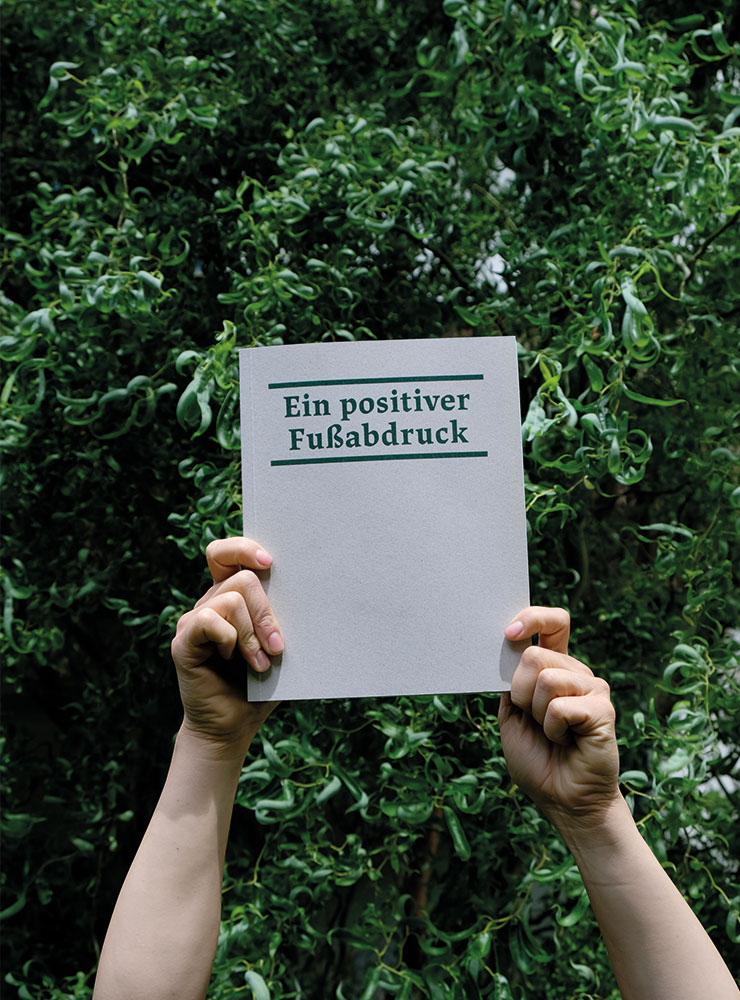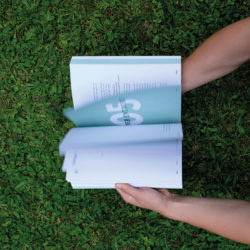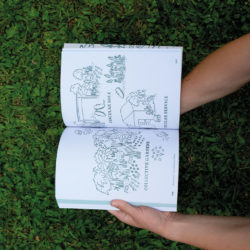Ein positiver Fußabdruck
Description
The goal of my diploma thesis is to find out how the product life cycle of sneaker soles made of natural rubber from Sri Lanka, could be designed in a circular way. In order to investigate this research question, the work is structured in three parts: the “as-is state“, the “mediating level“ and the “speculative level“. The examination of the “as-is state“ forms the basis of the work and includes corresponding research that analyzes the complexity and challenges of the product life cycle and examines its ecological and social interrelationships. Based on this investigation, possible potentials for sustainable improvements in product development are identified and shown on the "speculative level". The method used here is the development of a utopia, which, as a draft for the future, can provide strategies and solutions for the present. By currently presenting the seemingly impossible as a possible reality, the utopia expands the view of the present and thus promotes innovative thinking beyond established boundaries. The utopia in my work consists of three concrete scenarios. These scenarios provide speculative answers to the questions: How could rubber be produced ecologically and fairly? How could rubber soles be made circular? How could rubber soles be recycled in closed circuits? However, in order to derive such fictional ideas, real political perspectives are also required, which are represented by the “mediating level”. In this way, it forms the interface between both sides and illuminates current developments with an outlook to the future. In addition, it extends the perspectives common in literature to individual, practice-relevant perspectives. For this purpose, various experts and those affected by the topic were spoken to. It was particularly important to learn how the interview partners assess the problems of the present, which steps the are already taking, and what their view of the future is. My diploma thesis represents a consideration of sustainable product development between fiction, innovation, and feasibility.What is the Topic?
From a global perspective, the textile clothing industry is the second-largest sector of consumer goods. Clothing is bought a lot and "shopping" has recently become a hobby for many. One category that is particularly popular is Sneakers. In Germany alone, the market volume for 2021 will be 57.67 million pairs. That means a new pair of almost 80% of the German population. So sneakers are a mass product that is worn across generations and has developed into a lifestyle product. But like everywhere in the textile industry, sneakers also cause numerous ecological and social problems through production, use and disposal. Labor law violations, extremely low wages and the discrimination of workers, are a problem along the entire supply chain. The production of new textiles also consumes enormous amounts of resources, water and energy, and the use of toxic chemicals and pesticides pollutes the environment. In addition, millions of tons of used clothing are produced every year, which can hardly be recycled as raw material and to a large extent, are not biodegradable. Textiles also cause environmental pollution during use. For example, the abrasion generated by the soles of shoes makes the 7th place among those products that cause microplastics, with 109 grams per person per year. In addition, the supply chains of textile products, like sneakers, are extremely complex due to globalization of the markets and the use of different materials. Design decisions, for example, have far-reaching consequences along the entire product life cycle with regard to the choice of materials within a product. The product life cycle encompasses all levels of effectiveness of a product, i.e. raw material extraction, further processing, manufacturing, use and the end of life. A change in the textile industry from exploitative and environmentally harmful practices towards sustainable alternatives, therefore, appears to be urgently necessary. And that also applies to the category of sneakers, whose relevance and popularity is constantly increasing. The topic and the research question of my work result from this problem: How could the product life cycle of natural rubber sneaker soles in Sri Lanka be designed sustainable, recyclable and circular? My work also deliberately focuses on only one component of the sneaker, the sole, as the most characteristic part. This is to keep the complexity of the topic in a reasonable framework. For the same reason, this work will be limited to the original material, natural rubber, even if sneaker soles can consist of different materials.
Why does it look like this?
To date, there has been no consensus on the role of design and the range of problems, topics and areas of responsibility dealt with by designers is large. The list of artifacts, services and concepts that can be designed by designers is almost endless and growing steadily. In addition, design decisions in a globalized world can have far-reaching consequences at various levels. As a result, the responsibilities of designers are expanding. As a designer, you should ask yourself the question of what consequences your own design has on people and the environment and what scope for action your own role enables. In the case of this work, it is therefore investigated what it means when a designer decides to use a certain material in a certain context. For this reason, this work explores the design options within an entire product life cycle and examines how sustainable product development looks like and how far you can go as a designer. This work is intended to examine the interdependencies of design decisions, namely: which material from which origin is used for which purpose in which context. The design plays networking and linking role, which can bring clarity into a complex state, create connections, triggers cognitive processes and works out potentials. For this reason, it is also important in the context of this work to include the knowledge and positions of experts and those affected and to integrate them into the design context. From this position, the present work can be described less as a classic product design project, and much more as research through design. This research and the resulting potential for action should thus create the basis for sustainable product development.
What is special?
Even if "fast fashion" still determines the mainstream of fashion, sustainable fashion is becoming increasingly important for consumers under terms like "eco-fashion" or "slow-fashion". Many companies are now taking part in this trend, from the very big to the very small. Accordingly, more and more “sustainable” sneakers are being brought onto the market. Included are sneakers made of ocean plastic, old car tires or pineapple leather. However, it is often not clear which definition of sustainability these products are based on. So often supposedly sustainable models are, at a closer look, not really good alternatives. What is special about my work is, on the one hand, that the term sustainability, which is used in inflationary in current debates, is clearly defined in the course of this work. The question of sustainable product development in this work is a clearly formulated sustainability strategy. Because in order to develop truly sustainable products, a long-term strategy is required that does not merely reduce the use of materials but designs them from scratch. In addition, sneakers at the various process stages of production and along the entire product life cycle, create social problems and severe environmental pollution. At this point, my work is characterized by a truly holistic view of the entire product life cycle, from the raw material to the end of life, which is often missing in the current debate.
What is new?
I think the approach of "speculative design" in sustainable product development and with regard to entire product life cycles, is new and could help enormously to test ideas and approaches that can give important impulses for innovations and can possibly be transferred into future solutions. In the course of my work, based on extensive research, I have created utopias that provide very concrete approaches for current practice. Current conditions, circumstances and resources often place significant restrictions on questions of product development, and especially of sustainable product development. And due to that, there is a significant risk that problems that are supposed to be solved, get postponed or important innovation potential is overlooked. In particular, concepts such as the circular economy fail in the present due to currently missing conditions. The innovation potential of new concepts is often nipped in the bud. But even though some concepts may lack certain conditions, their continuous development is still extremely important. For example, if a lot of products were developed, all of which need a particular composting facility to be broken down, such a composting plant would sooner or later become a reality. Utopias as ideal states, derived from desires, ideas and knowledge and could be used as testing tools for the present and all further steps taken towards sustainable development. In general, the design concept of "speculative design" is used rather to stimulate the imagination of topics with a general socio-cultural or socio-technological context, but it also has great potential in the area of product development.




